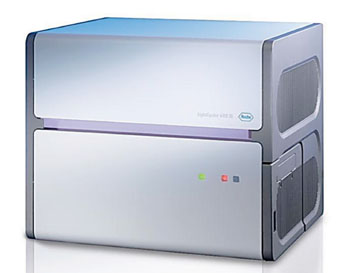Colorectal Cancer Relapses Predicted by Expression of Five Genes
By LabMedica International staff writers
Posted on 02 Oct 2014
The analysis of five differentially expressed genes could be used to classify colorectal tumors, predict the evolution of the patient and thus take appropriate clinical decisions to prevent relapses. Posted on 02 Oct 2014
In order to accurately identify the characteristics of each tumor, good biomarkers are needed to predict the outcome of each patient and both malignant cells and normal accompanying cells which are a particular microenvironment, can be a source of these biomarkers.

Image: The LightCycler 480 Instrument for polymerase chain reactions (Photo courtesy of Roche Applied Science).
Scientists the Catalan Institute of Oncology-Bellvitge Biomedical Research Institute (ICO-IDIBELL; Catalonia, Spain) developed a tool based on the expression of five genes characteristic of the tumor microenvironment that allows classifying very accurately the prognosis of patients suffering from colorectal cancer (CRC) at an intermediate stage of the disease. Validation was performed in a metacohort of 317 and 142 CRC patients by means of real-time polymerase chain reaction (RT-PCR). To demonstrate that these five genes have prognostic value if the stroma is present in a given sample, they checked the signature in two independent datasets of LCM (Laser Capture Microscope) epithelial cell-enriched samples.
The selected genes were: chemokine (C-C motif) ligand 11 (CCL11), which is down regulated in carcinoma-associated fibroblasts (CAFs), versus paired normal colonic fibroblasts (NCF); and a protective gene; PDZ and LIM Domain 3 (PDLIM3), adhesion molecule with Ig-like domain 2 (AMIGO2), Solute Carrier Family 7 (Cationic Amino Acid Transporter, Y+ System), Member 2 (SLC7A2), and UL16 binding protein 2 (ULBP2), all overexpressed in CAFs versus paired NCF. RNA quantity was determined by NanoDrop ND-1000 spectrophotometer (NanoDrop Technologies Inc.; Rockland, DE, USA). Quantitative PCR assays were performed with the LightCycler 480 (Roche Applied Science; Mannheim, Germany).
The authors concluded that the CAFs-derived five-gene classifier provided more accurate information about outcome than conventional clinicopathological criteria and it could be useful to take clinical decisions, especially in Stage II colorectal cancer. Additionally, the classifier put into relevance the CAF’s intratumoral heterogeneity and might contribute to find relevant targets for depleting adequate CAF’s subtypes.
David Garcia-Molleví, PhD, the principal investigator of the study said, “With the analysis of only five genes by routine techniques, we provide very precise information about the likelihood of relapse and the appropriateness of administering chemotherapy patients with stage II disease.” The study was published on August 30, 2014, in the journal Oncotarget.
Related Links:
Catalan Institute of Oncology
NanoDrop Technologies Inc.
Roche Applied Science














